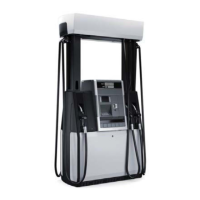Each pump has its own pipe system from the underground tank. Due to the high vapour pressure,
RVP, in most fuel types, there are additional items to check in all suction systems:
•
make sure that the fuel line/tank has no leaks
•
a define slope towards the tank (at installation)
•
has no vapour lock
•
has a flow capacity as required
•
the tank minimum fuel level should never exceed 4m below the pump inlet
The vacuum measured at the pump inlet should never drop below -40 kPa (-6 psi) during filling
and -30 kPa (-4 psi) when idling. If these values are exceeded, there are risks of evaporation in
the fuel lines causing flow drops or unstable flow during filling.
Note!
If the above conditions are not obtained, the capacity will not be sufficient for the required flow
and performance that is expected by the customer.
11.5.1 Vacuum Test
To perform a vacuum test, install a vacuum gauge at the test port shown in Fig 11.3.
For this test only, install the vacuum gauge and turn on the pump. Open the nozzle and begin
dispensing product. The reading should be approximately 2.5 cm (1 inch) of vacuum for each
.6 m (1-1/2 ft) of static lift. Static lift is the vertical distance from the bottom of the pumping unit
to the level of product in the tank. The actual reading may vary slightly depending on the horizontal
run, the number of elbows in the line, the size of the suction pipe, etc.
A high reading indicates that there is a restriction in the suction line. This restriction could be a
stuck check valve, a crushed suction pipe, or debris in the tank. A low vacuum reading indicates
one of two things: either the pumping unit is defective, or the pumping unit is drawing air into the
suction line.
WM048523 Rev 08 01/2019 187
11 Suction Pumps

